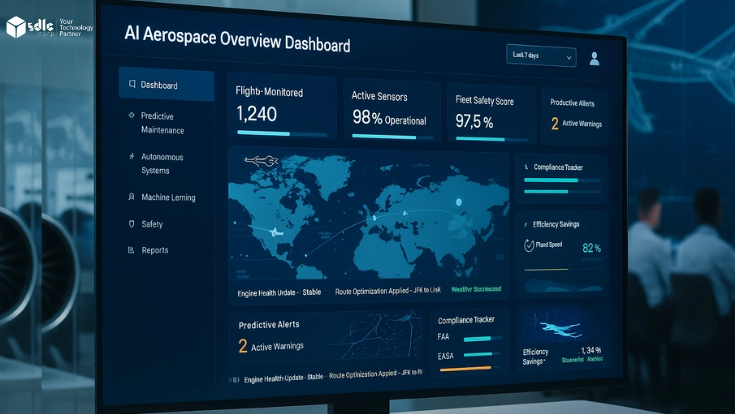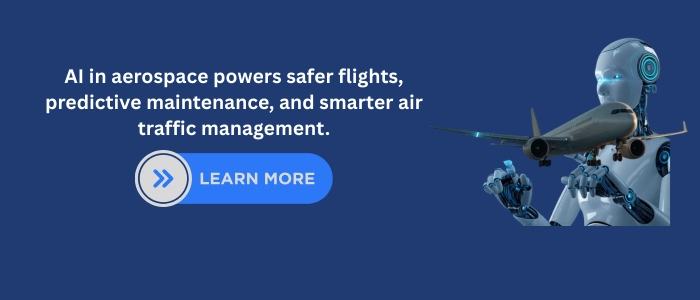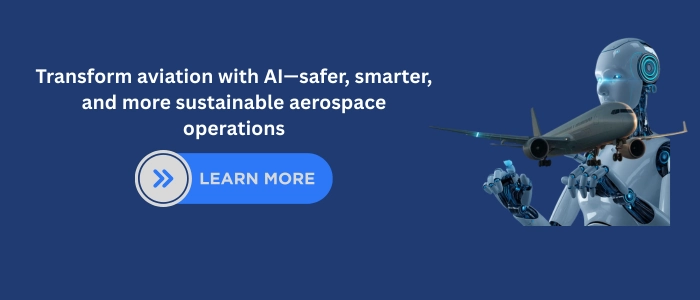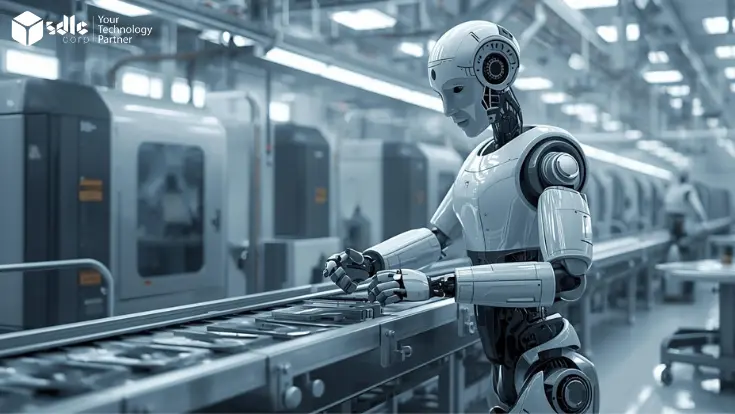Introduction
AI in aerospace is transforming one of the world’s most complex and safety-critical industries. From real-time flight monitoring to predictive maintenance and autonomous systems, artificial intelligence is now central to how modern aviation operates. The technology enables engineers, pilots, and controllers to process massive datasets, identify risks faster, and make informed decisions with greater accuracy.
AI in aerospace is not a passing trend but a critical technology. It processes large datasets in real time, identifies patterns, and provides accurate insights that help engineers, pilots, and controllers make better decisions. Unlike static programs, AI adapts and improves with experience. This flexibility is vital for industries where risks are high and the margin for error is close to zero.
In this blog, we will examine how AI supports predictive maintenance aerospace practices, ensures reliability in autonomous flight systems, and delivers results through aerospace machine learning applications. We will also look at AI safety in aerospace and how AI is optimizing air traffic with AI. Each section presents practical insights, technical details, and future directions.
For a broader view on AI’s impact across industries, you can also read our article on Artificial Intelligence Evolution
The Role of AI in Aerospace
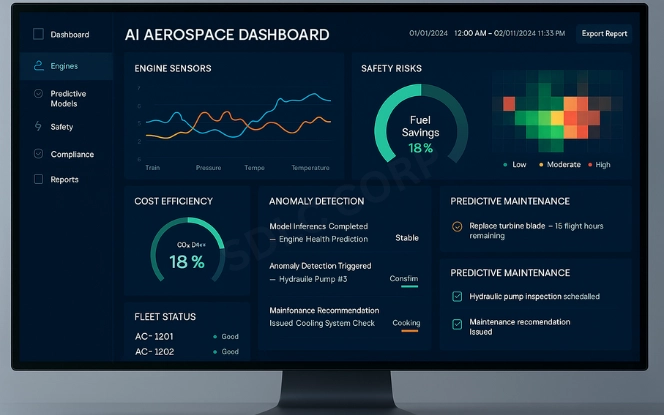
AI strengthens aerospace operations by handling data-intensive processes where manual methods fall short. Aircraft generate terabytes of information every flight. Processing this data is beyond human capacity, but AI systems handle it efficiently.
Core contributions of AI include:
- Real-time monitoring: Continuous tracking of sensors and performance metrics.
- Risk detection: Algorithms spot irregularities before they escalate.
- Efficiency gains: Automation reduces delays and operating costs.
- Environmental benefits: Optimized routes save fuel and reduce emissions.
For example, manufacturers use AI-driven simulations to test material strength and aerodynamic behavior. Instead of years of physical testing, they achieve accurate results in weeks. Airlines apply similar systems to forecast passenger demand and optimize routes, which reduces costs and ensures smoother operations.
By embedding AI in aerospace, the sector moves closer to safer, greener, and more reliable skies.
Predictive Maintenance in Aerospace
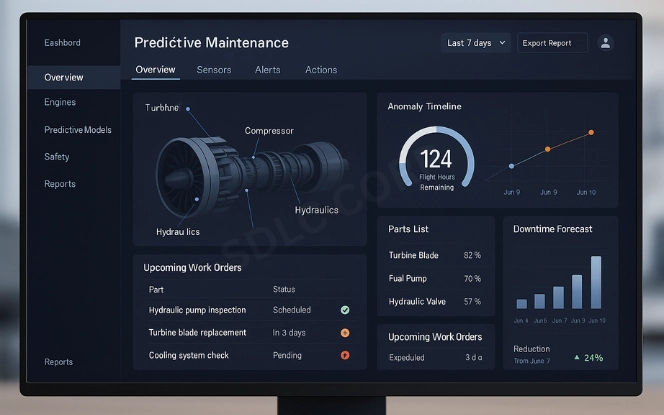
Aircraft maintenance is expensive and time-consuming, but unavoidable. Failures that occur mid-flight or during take-off can have catastrophic consequences. AI-powered predictive maintenance aerospace practices provide a way to minimize risks and costs.
How predictive maintenance works:
- Data collection: Sensors capture information from engines, landing gear, hydraulics, and avionics.
- Machine learning models: Algorithms process this data to detect unusual patterns or vibrations.
- Actionable alerts: Maintenance teams receive early warnings about components at risk of failure.
- Resource optimization: Parts are repaired or replaced only when necessary, avoiding unnecessary costs.
For instance, Rolls-Royce uses AI-driven “digital twins” of aircraft engines. These digital models simulate real-time engine conditions, predicting wear and tear well before a failure occurs. Airlines applying these solutions report fewer unplanned breakdowns and millions saved annually in maintenance costs.
The benefits include:
- Reduced downtime due to proactive repairs.
- Improved passenger safety through early detection of risks.
- Extended lifespan of parts and engines.
- Lower operating costs for airlines and manufacturers.
Predictive maintenance is a clear example of how AI in aerospace directly translates into practical value. It combines cost savings with safety improvements, proving AI is more than an experimental technology.
You may also find our blog on Generative AI for Aerospace Across Industries useful for related applications.
Autonomous Flight Systems
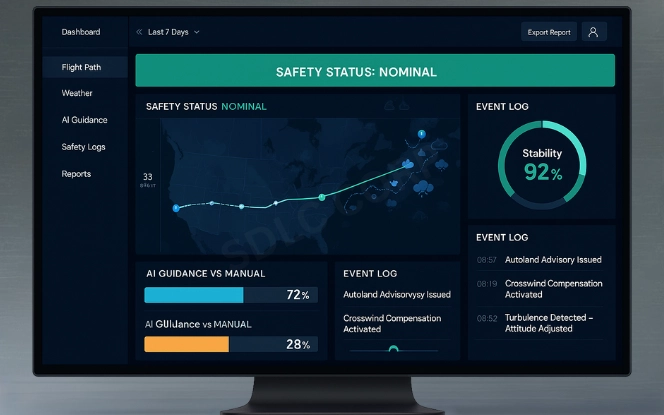
AI’s role in autonomous flight systems is one of the most ambitious areas of research. These systems combine machine learning, navigation algorithms, and advanced sensors to control aircraft functions.
Autonomous systems support pilots in tasks such as:
- Navigation assistance: Algorithms suggest optimal flight paths based on weather and air traffic.
- Emergency handling: AI evaluates real-time data during unexpected situations to support pilot decisions.
- Routine automation: Flight take-offs, landings, and altitude adjustments can be semi-automated.
Commercial drones already use autonomous navigation to perform surveillance, crop monitoring, and package delivery. Aerospace companies are now testing similar technologies in larger aircraft. While fully autonomous passenger flights are not yet approved, hybrid solutions that reduce pilot workload are already in place.
The long-term vision is to reduce human error, which is a major contributor to accidents. By combining human judgment with AI precision, autonomous flight systems can create safer skies.
Learn how automation is reshaping mobility in our piece on Generative AI for the Automotive Industry
Aerospace Machine Learning Applications
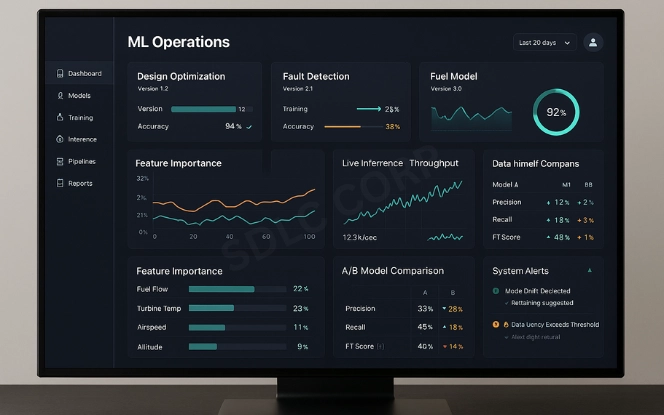
Machine learning forms the backbone of AI adoption in aerospace. Its applications extend across multiple domains:
- Design optimization: ML accelerates design simulations by analyzing outcomes from previous models.
- Fault detection: Algorithms identify structural or mechanical faults earlier than traditional checks.
- Supply chain management: Predictive models ensure that parts are available before shortages occur.
- Fuel optimization: Data-driven recommendations help pilots minimize fuel consumption.
When designing a new aircraft model, engineers test thousands of design variations. Traditionally, this would take years and cost billions. With machine learning, simulations run faster, drawing on decades of historical performance data. This results in safer designs developed in less time.
Another case is crew scheduling. AI systems balance operational efficiency with human constraints like rest hours and labor laws. Airlines that implement such solutions report improved punctuality and better workforce management.
These aerospace machine learning applications prove AI’s impact is not limited to technology, it also reshapes business operations.
For practical use cases in business settings, see our blog on Introduction to Machine Learning
AI Safety in Aerospace
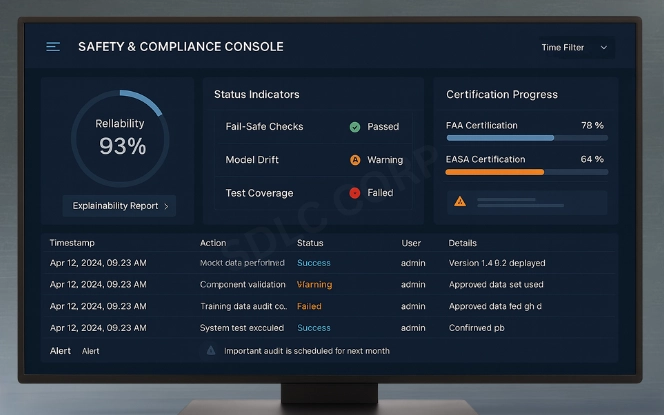
Safety defines aerospace, and AI must align with the sector’s uncompromising standards. Unlike other industries, even a minor system failure in aviation can have severe consequences. AI safety in aerospace ensures reliability, accountability, and transparency.
Key safety factors include:
- Reliability: AI must perform consistently under all operating conditions, including rare emergencies.
- Explainability: Algorithms must provide reasoning that engineers, regulators, and pilots can interpret.
- Transparency: Systems should be auditable to ensure compliance with safety standards.
Regulatory agencies such as the FAA and EASA are drafting frameworks that include stress tests, simulation-based validation, and detailed documentation requirements. These measures ensure that AI is not a “black box” but a trusted partner in aviation.
Practical steps to maintain safety include human-in-the-loop systems, redundant algorithms to cross-check results, and continuous monitoring of AI decisions. Each safeguard builds trust and reduces risks.
AI safety in aerospace is not about slowing adoption. It is about securing innovation so that airlines and manufacturers can scale AI without compromising the industry’s reputation for reliability.
Optimizing Air Traffic with AI
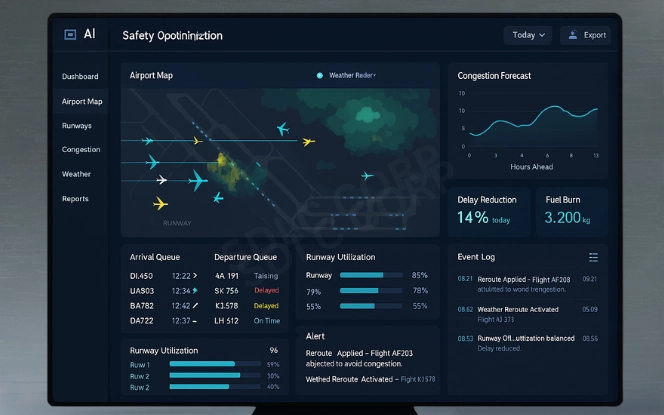
Air traffic is growing rapidly, putting pressure on airports and controllers. Optimizing air traffic with AI offers a scalable way to manage this complexity.
AI contributions include:
- Forecasting passenger demand and aircraft movements.
- Suggesting alternate routes to balance airspace congestion.
- Integrating weather, radar, and satellite inputs for real-time decision-making.
- Reducing idle time on runways to cut fuel costs and emissions.
Real-world trials in Europe have shown promising results. AI-driven scheduling tools shortened average landing delays by several minutes. At scale, this saves fuel, improves punctuality, and reduces carbon emissions.
The benefits extend beyond efficiency:
- Safety: AI assists controllers in handling high workloads with greater precision.
- Sustainability: Optimized routes lower emissions.
- Passenger experience: Reduced delays mean smoother journeys.
Optimizing air traffic with AI is becoming essential as global travel rises. It is a practical solution that balances safety, cost, and sustainability.
Challenges and Limitations
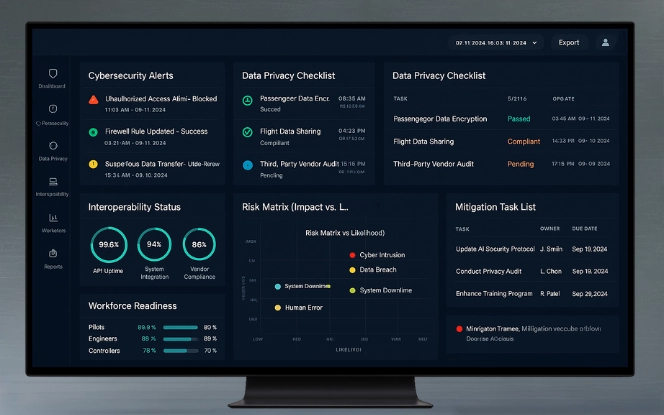
Despite strong potential, AI adoption in aerospace faces challenges.
Key obstacles include:
- Cybersecurity risks: AI relies on constant data transfer, which could be targeted by hackers.
- Data privacy: Sensitive flight and passenger data require strict handling.
- Lack of standardization: Different manufacturers use proprietary AI models, complicating integration.
- Workforce readiness: Pilots, engineers, and controllers must be trained to collaborate with AI systems.
These challenges create friction but are not insurmountable. Global collaboration among regulators, industry leaders, and researchers is underway to set benchmarks.
In practice, companies address these risks through encrypted communication channels, AI model audits, and specialized training programs. As these safeguards mature, barriers will reduce.
Challenges will remain, but history shows aerospace adapts to new technologies. With clear rules and investment in training, AI can be safely scaled across the industry.
Future Outlook
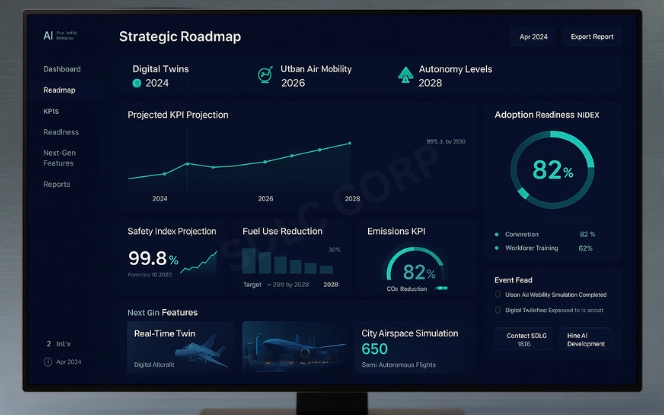
The future of AI in aerospace will focus on deeper integration across systems.
Key trends expected in the next decade:
- Predictive maintenance: Moving toward digital twins for real-time fleet monitoring.
- Autonomous flight systems: Expanding from drones to regional passenger planes and air taxis.
- Machine learning in operations: Optimizing routes, schedules, and supply chains.
- Regulatory frameworks: Stronger global standards for AI certification.
- Sustainability goals: AI-driven solutions to reduce emissions and fuel use.
Digital twin technology is one of the most promising areas. By replicating entire aircraft digitally, engineers can predict faults instantly and simulate operational changes. Meanwhile, urban air mobility concepts like autonomous taxis will depend on AI to function safely in dense city airspace.
The outlook is clear: AI will not replace humans but will enhance expertise. Its role will grow from supportive tools to indispensable systems shaping the future of aerospace.
Conclusion
AI in aerospace is no longer confined to research, it is shaping everyday operations. Predictive maintenance aerospace solutions reduce downtime and improve reliability. Autonomous flight systems assist pilots and create possibilities for drones and urban mobility. Aerospace machine learning applications streamline design, fuel management, and crew scheduling. AI safety in aerospace ensures that these tools comply with the highest standards. Optimizing air traffic with AI addresses congestion, delays, and sustainability challenges.
Together, these advances demonstrate that AI is a foundation for future growth. Airlines and manufacturers that invest now will gain long-term advantages in safety, efficiency, and compliance. Those that wait risk falling behind as AI becomes standard practice.
Organizations should act today. Contact us SDLC Corp to discuss practical ways AI can strengthen your aerospace operations. To accelerate adoption, Hire AI Development Services with SDLC Corp and create solutions that are efficient, secure, and future-ready.
AI in aerospace is not about replacing human expertise but amplifying it. By blending machine precision with human judgment, the industry can build safer, greener, and more innovative skies.
FAQs
How Is AI In Aerospace Transforming The Industry?
AI in aerospace is transforming the industry by enabling real-time data analysis, improving safety through predictive maintenance of aerospace systems, and reducing costs with automated decision-making. It helps manufacturers, airlines, and regulators achieve efficiency without compromising safety.
What Are The Benefits Of Predictive Maintenance Aerospace Solutions?
Predictive maintenance aerospace solutions reduce downtime, prevent unexpected failures, and extend the lifespan of aircraft components. By using machine learning to analyze sensor data, airlines save millions in maintenance costs and improve passenger safety.
How Do Autonomous Flight Systems Improve Aviation Safety?
Autonomous flight systems use AI algorithms to assist pilots with navigation, emergency management, and automated controls. These systems reduce human error, making flights safer and more efficient, while also enabling innovations such as drones and urban air taxis.
What Are The Main Aerospace Machine Learning Applications?
Aerospace machine learning applications include design optimization, fault detection, crew scheduling, and fuel efficiency modeling. These applications support both engineering and business operations, proving that AI adds value beyond technical performance.
How Is AI Optimizing Air Traffic With AI Technologies?
AI is optimizing air traffic with AI tools that forecast flight demand, integrate weather data, and reduce runway congestion. Airports using these technologies report shorter delays, lower fuel costs, and improved sustainability outcomes.

